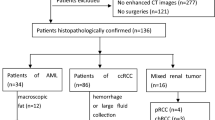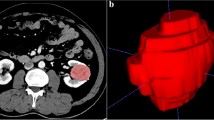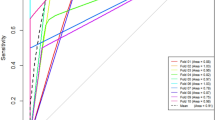Abstract
Objective
The aim is to develop a radiomics model based on contrast-enhanced CT scans for preoperative prediction of perirenal fat invasion (PFI) in patients with renal cell carcinoma (RCC).
Methods
The CT data of 131 patients with pathology-confirmed PFI status (64 positives) were retrospectively collected and randomly assigned to the training and test datasets. The kidneys and the masses were annotated by semi-automatic segmentation. Eight types of regions of interest (ROI) were chosen for the training of the radiomics models. The areas under the curves (AUCs) from the receiver operating characteristic (ROC) curve analysis were used to analyze the diagnostic performance. Eight types of models with different ROIs have been developed. The models with the highest AUC in the test dataset were used for construction of the corresponding final model, and comparison with radiologists’ diagnosis.
Results
The AUCs of the models for each ROI was 0.783–0.926, and there was no statistically significant difference between them (P > 0.05). Model 4 was using the ROI of the outer half-ring which extended along the edge of the mass at the outer edge of the kidney into the perirenal fat space with a thickness of 3 mm. It yielded the highest AUC (0.926) and its diagnostic accuracy was higher than the radiologists’ diagnosis.
Conclusion
We have developed and validated a radiomics model for prediction of PFI on RCC with contrast-enhanced CT scans. The model proved to be more accurate than the radiologists’ diagnosis.




Similar content being viewed by others
References
Capitanio U, Bensalah K, Bex A et al (2019) Epidemiology of Renal Cell Carcinoma. Eur Urol 75(1):74-84
Amin MB, Greene FL, Edge SB et al (2017) The Eighth Edition AJCC Cancer Staging Manual: Continuing to build a bridge from a population-based to a more “personalized” approach to cancer staging. CA Cancer J Clin 67(2):93-99
Shah PH, Lyon TD, Lohse CM et al (2019) Prognostic evaluation of perinephric fat, renal sinus fat, and renal vein invasion for patients with pathological stage T3a clear-cell renal cell carcinoma. Bju Int 123(2):270-276
Lee H, Lee M, Lee SE et al (2018) Outcomes of pathologic stage T3a renal cell carcinoma up-staged from small renal tumor: emphasis on partial nephrectomy. Bmc Cancer 18(1):427
Xu X, Zhu D (2021) Prognostic significance of subclassifying stage pT3a renal tumors with fat invasion: a retrospective study of 99 patients. J Int Med Res 49(8):675873190
Brookman-May SD, May M, Wolff I et al (2015) Evaluation of the prognostic significance of perirenal fat invasion and tumor size in patients with pT1-pT3a localized renal cell carcinoma in a comprehensive multicenter study of the CORONA project. Can we improve prognostic discrimination for patients with stage pT3a tumors? Eur Urol 67(5):943-951
Jeon HG, Jeong IG, Kwak C, Kim HH, Lee SE, Lee E (2009) Reevaluation of renal cell carcinoma and perirenal fat invasion only. J Urol 182(5):2137-2143
Ljungberg B, Cowan NC, Hanbury DC et al (2010) EAU guidelines on renal cell carcinoma: the 2010 update. Eur Urol 58(3):398-406
Catalano C, Fraioli F, Laghi A et al (2003) High-resolution multidetector CT in the preoperative evaluation of patients with renal cell carcinoma. AJR Am J Roentgenol 180(5):1271-1277
Tsili AC, Goussia AC, Baltogiannis D et al (2013) Perirenal fat invasion on renal cell carcinoma: evaluation with multidetector computed tomography-multivariate analysis. J Comput Assist Tomogr 37(3):450-457
Sheth S, Scatarige JC, Horton KM, Corl FM, Fishman EK (2001) Current concepts in the diagnosis and management of renal cell carcinoma: role of multidetector ct and three-dimensional CT. Radiographics 21 Spec No:S237-S254
Kopka L, Fischer U, Zoeller G, Schmidt C, Ringert RH, Grabbe E (1997) Dual-phase helical CT of the kidney: value of the corticomedullary and nephrographic phase for evaluation of renal lesions and preoperative staging of renal cell carcinoma. AJR Am J Roentgenol 169(6):1573-1578
Kim C, Choi HJ, Cho KS (2014) Diagnostic performance of multidetector computed tomography in the evaluation of perinephric fat invasion in renal cell carcinoma patients. J Comput Assist Tomogr 38(2):268-273
Nazim SM, Ather MH, Hafeez K, Salam B (2011) Accuracy of multidetector CT scans in staging of renal carcinoma. Int J Surg 9(1):86-90
Sokhi HK, Mok WY, Patel U (2015) Stage T3a renal cell carcinoma: staging accuracy of CT for sinus fat, perinephric fat or renal vein invasion. Br J Radiol 88(1045):20140504
Landman J, Park JY, Zhao C et al (2017) Preoperative Computed Tomography Assessment for Perinephric Fat Invasion: Comparison With Pathological Staging. J Comput Assist Tomogr 41(5):702-707
Ucer O, Muezzinoglu T, Ozden E et al (2021) How accurate is radiological imaging for perirenal fat and renal vein invasion in renal cell carcinoma? Int J Clin Pract 75(9)
Hodgdon T, McInnes MDF, Schieda N, Flood TA, Lamb L, Thornhill RE (2015) Can Quantitative CT Texture Analysis be Used to Differentiate Fat-poor Renal Angiomyolipoma from Renal Cell Carcinoma on Unenhanced CT Images? Radiology 276(3):787-796
Raman SP, Chen Y, Schroeder JL, Huang P, Fishman EK (2014) CT Texture Analysis of Renal Masses. Acad Radiol 21(12):1587-1596
Bektas CT, Kocak B, Yardimci AH et al (2019) Clear Cell Renal Cell Carcinoma: Machine Learning-Based Quantitative Computed Tomography Texture Analysis for Prediction of Fuhrman Nuclear Grade. Eur Radiol 29(3):1153-1163
Kocak B, Yardimci AH, Bektas CT et al (2018) Textural differences between renal cell carcinoma subtypes: Machine learning-based quantitative computed tomography texture analysis with independent external validation. Eur J Radiol 107:149-157
Feng Z, Rong P, Cao P et al (2018) Machine learning-based quantitative texture analysis of CT images of small renal masses: Differentiation of angiomyolipoma without visible fat from renal cell carcinoma. Eur Radiol 28(4):1625-1633
Zabihollahy F, Schieda N, Krishna S, Ukwatta E (2020) Automated classification of solid renal masses on contrast-enhanced computed tomography images using convolutional neural network with decision fusion. Eur Radiol 30(9):5183-5190
Suarez-Ibarrola R, Basulto-Martínez M, Heinze A, Gratzke C, Miernik A (2020) Radiomics Applications in Renal Tumor Assessment: A Comprehensive Review of the Literature. Cancers 12(6):1387
Kunapuli G, Varghese B, Ganapathy P et al (2018) A Decision-Support Tool for Renal Mass Classification. J Digit Imaging 31:929-939
Yan L, Liu Z, Wang G et al (2015) Angiomyolipoma with Minimal Fat. Acad Radiol 22(9):1115-1121
Yu H, Scalera J, Khalid M et al (2017) Texture analysis as a radiomic marker for differentiating renal tumors. Abdom Radiol 42(10):2470-2478
Ghosh P, Tamboli P, Vikram R, Rao A (2015) Imaging-genomic pipeline for identifying gene mutations using three-dimensional intra-tumor heterogeneity features. Journal of Medical Imaging 2(4):41009
Antunes J, Viswanath S, Rusu M et al (2016) Radiomics Analysis on FLT-PET/MRI for Characterization of Early Treatment Response in Renal Cell Carcinoma: A Proof-of-Concept Study. Transl Oncol 9(2):155-162
Lin Z, Cui Y, Liu J et al (2021) Automated segmentation of kidney and renal mass and automated detection of renal mass in CT urography using 3D U-Net-based deep convolutional neural network. Eur Radiol 31(7):5021-5031
van Griethuysen JJM, Fedorov A, Parmar C et al (2017) Computational Radiomics System to Decode the Radiographic Phenotype. Cancer Res 77(21):e104-e107
Song Y, Zhang J, Zhang Y et al (2020) FeAture Explorer (FAE): A tool for developing and comparing radiomics models. Plos One 15(8):e237587
Ljungberg B, Albiges L, Abu-Ghanem Y et al (2019) European Association of Urology Guidelines on Renal Cell Carcinoma: The 2019 Update. Eur Urol 75(5):799-810
Hallscheidt PJ, Bock M, Riedasch G et al (2004) Diagnostic Accuracy of Staging Renal Cell Carcinomas Using Multidetector-Row Computed Tomography and Magnetic Resonance Imaging: A Prospective Study with Histopathologic Correlation. J Comput Assist Tomo 28(3):333-339
Caillaud M, Laisney M, Bejanin A et al (2019) Is multidetector CT-scan able to detect T3a renal tumor before surgery? 53(5):350-355
Ma S, Xie H, Wang H et al (2020) Preoperative Prediction of Extracapsular Extension: Radiomics Signature Based on Magnetic Resonance Imaging to Stage Prostate Cancer. Mol Imaging Biol 22(3):711-721
Funding
This study has received funding by the Scientific Research Seed Fund of Peking University First Hospital [grant numbers 2021SF29].
Author information
Authors and Affiliations
Corresponding author
Ethics declarations
Conflict of interest
Co-author Yaofeng Zhang and Xiangpeng Wang are from a medical technical corporation provided technical support for model development. The data from this study was analyzed and controlled by authors who are from Peking University First Hospital. The authors declare that they have no conflict of interest.
Ethical approval
Institutional Review Board approval was obtained. Written informed consent was waived by the Institutional Review Board.
Additional information
Publisher's Note
Springer Nature remains neutral with regard to jurisdictional claims in published maps and institutional affiliations.
Supplementary Information
Below is the link to the electronic supplementary material.
Rights and permissions
Springer Nature or its licensor (e.g. a society or other partner) holds exclusive rights to this article under a publishing agreement with the author(s) or other rightsholder(s); author self-archiving of the accepted manuscript version of this article is solely governed by the terms of such publishing agreement and applicable law.
About this article
Cite this article
Liu, J., Lin, Z., Wang, K. et al. A preliminary radiomics model for predicting perirenal fat invasion on renal cell carcinoma with contrast-enhanced CT images. Abdom Radiol 48, 649–658 (2023). https://doi.org/10.1007/s00261-022-03699-8
Received:
Revised:
Accepted:
Published:
Issue Date:
DOI: https://doi.org/10.1007/s00261-022-03699-8




